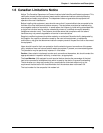
12
DataTalker Owner’s Manual
1.4 System Features
1.4.1 Voice/Fax
The voice/fax feature of the DataTalker allows you to establish voice or fax traffic on top of your
normal data communications over a composite link, saving the expense of extra communications
lines. The DataTalker provides three types of telephone circuits (FXS, FXO, and E&M) that allow
a telephone, a fax machine, a PBX station card, or a PBX E&M trunk to be directly connected to
it. In one configuration, these telephone circuits cause the telephone at a remote location to ring
when you pick up the handset on the local telephone. In another configuration, an off-site
extension moves your office extension to a remote location. In a third configuration, you can use
the DataTalker to tie two PBXes together.
1.4.2 Data Channel
The DataTalker data channel is able to accommodate any asynchronous device or any SDLC/
HDLC synchronous device. Configuration of the data channel is controlled by menus that
determine the mode of operation (sync or async), whether or not clocking is necessary, the
speed of the channel, and a number of async channel conditioning parameters.
1.4.3 Composite Link
The DataTalker’s
composite link is capable of synchronous and full duplex communications with
an internal or external link device. Using an internal modem, ISDN terminal adapter, DSU, or
external device, the DataTalker can be connected to different types of communications links,
such as a dial-up line, a leased line, a Basic Rate Interface (BRI) ISDN service, or a DDS
network. If an external link device is used, the DataTalker can communicate with it using either
the RS232 or V.35 standard.
1.4.4 Flow Control
Flow control regulates the volume of data entering the data port. When the channel buffer is
almost full, a flow control command is issued which tells the device attached to the data port to
stop sending data. The devices on both ends of the link must be configured for the same flow
control method. The most common flow control methods are XON/XOFF and RS232C signal
control (using CTS). The DataTalker supports these and ENQ/ACK.
DATA DATA
Channel
Device
Channel
Device
CHANNEL DEVICE-
INITIATED PACING
DataTalker DataTalker
DATATALKER-INITIATED
FLOW CONTROL
Pacing stops the output of
data from the DataTalker
Flow control stops the input
of data to the DataTalker
1.4.5 Parameter Memory
A nonvolatile memory for storing configurations and options means that the DataTalker remains
configured until you change it. You can configure a DataTalker and save the parameters to
memory, turn it off, ship it, and use it without having to reconfigure it.


















